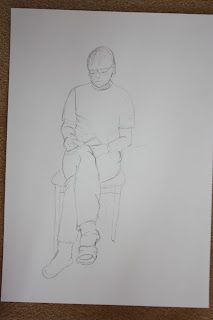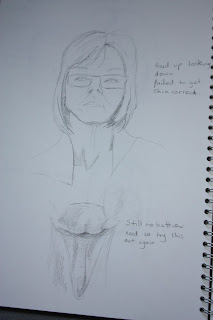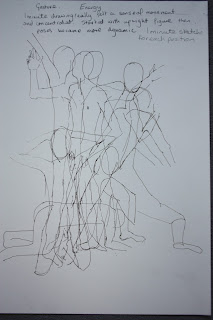Before I began this section I was not very confident in drawing people and I have to say how far I have come in overcoming this problem. Out of all the sections I have done so far this for me has been a turning point and I feel I could tackle most difficult poses with more attack and enthusiasm.
The first part of my assignment was a line drawing of a model sitting and I chose to use pen. I started with a few preliminary sketches to choose the pose I liked the best.
The first pose looked Ok but I wanted some more foreshortening on the drawing.
The second was again not what I wanted and I wanted to have more of the model's body to draw.
I chose this one as the front leg was coming toward me and I felt that this position presented more of a challenge.
The finished drawing I was quite pleased with and I put in some lines indicating light direction. I found getting the creases in the clothing drawn without tone quite challenging. I got the proportion right first time and since I started this section it is the one skill that I feel that I have moved forward on the most. At the begining I was constantly checking proportion and altering and adjusting but now I am still checking the proportion but I am finding that it is mostly correct first time and needs little adjustment.
The Finished Drawing
The second part of my assignment I had decided to use tinted charcoal, which I have used in a life class before and quite liked them. I had some paper larger that A2 and so chose a pastel paper similar to pastelmat. It was easy to work on and very robust if anything needed to be adjusted. I decided when my model sat down and was watching the football that I would be able to draw him. As I have drawn this person several times I decided rightly or wrongly to use the pose as he was so I did not try any other positions and I was very familiar with his shape and look. Also as he had posed for me several times his patience was running low!
On the whole I am satisfied with the results I hadn't used tinted charcoal on such a big piece of paper before and I liked the texture it produced on the faded jeans. The creases in the clothing were a challenge but a great exercise in understanding where the lights and darks appear on the creases.
On the whole I have thoroughtly enjoyed this whole section and I am continuing to do more life studies on a regular basis. I think that out of everything that I have done I now prefer to draw people which is a complete turn around for me.
Thursday, 28 June 2012
Tuesday, 26 June 2012
Self Portrait
I had never contemplated doing a self portrait but this exercise was illuminating and showed me the importance of really looking and studying the face, proportions, tone and expression. I got so into this exercise that I tried this out a few times on friends and family and found that I was getting a likeness. It was exciting and very satisfying and I would very much like to develop this further and try painting portraits.
I started with a few quick 10 to 15 mins sketches and I was surprised how much I could do in a short period of time. I then started to draw just my head and tried to get the shape and then tried my neck in various positions and the hardest position was looking up and getting the chin right.
It was quite a lesson in looking very closely for as long as you wanted and you didn't have to take into account a models feelings or patience!
I did two self protraits the first being in pencil and I think that it is a rather sterile looking picture not portraying very much about me. It looks rather photographic and although there is a likeness but it doesn't feel like me.
The second portrait I did was much more relaxed and somehow I think I have captured expression and people who have looked at it say it is by far the picture that captures me as a person. I am not usually happy about what I do but I cannot explain how weird I feel looking at this picture as technically there is a few things not right but somehow I am there. I used charcoal pencil and white chalk and I think that I could have blended a bit better.
Following this I decided to do some more portraits as I haven't tried these in the past and really enjoyed doing them and found that I could indeed get a likeness quite quickly. I then wanted to practice features particularly ears, so I drew my own ear and copied the other features from books. The portrait was done of a friend again very quickly
I also did a portrait of Robin Gibb that was in a Sunday magazine and really enjoyed this and I think he is recognizable. I concentrated very much on tone and I was pleased the way his hands turned out although not perfect.
The last exercise in this section was a self portrait from memory and I waited two weeks after I had done the other two portaits and again was amazed at the likeness.
I will certainly continue to explore portraits and I recently went to the Portrait Gallery to see the Lucien Freud exhibition and thoroughly enjoyed his work. His portraits tell stories and are not photographic in style, he portrays mood and emotion and his wide eyed portrait of Kitty is almost disturbing. His style doesn't flatter his sitter and there was much criticism of his portrait of the Queen which is probably my least favourite of his work.
It was quite a lesson in looking very closely for as long as you wanted and you didn't have to take into account a models feelings or patience!
I did two self protraits the first being in pencil and I think that it is a rather sterile looking picture not portraying very much about me. It looks rather photographic and although there is a likeness but it doesn't feel like me.
The second portrait I did was much more relaxed and somehow I think I have captured expression and people who have looked at it say it is by far the picture that captures me as a person. I am not usually happy about what I do but I cannot explain how weird I feel looking at this picture as technically there is a few things not right but somehow I am there. I used charcoal pencil and white chalk and I think that I could have blended a bit better.
Following this I decided to do some more portraits as I haven't tried these in the past and really enjoyed doing them and found that I could indeed get a likeness quite quickly. I then wanted to practice features particularly ears, so I drew my own ear and copied the other features from books. The portrait was done of a friend again very quickly
I also did a portrait of Robin Gibb that was in a Sunday magazine and really enjoyed this and I think he is recognizable. I concentrated very much on tone and I was pleased the way his hands turned out although not perfect.
The last exercise in this section was a self portrait from memory and I waited two weeks after I had done the other two portaits and again was amazed at the likeness.
I will certainly continue to explore portraits and I recently went to the Portrait Gallery to see the Lucien Freud exhibition and thoroughly enjoyed his work. His portraits tell stories and are not photographic in style, he portrays mood and emotion and his wide eyed portrait of Kitty is almost disturbing. His style doesn't flatter his sitter and there was much criticism of his portrait of the Queen which is probably my least favourite of his work.
The Moving Figure
I did some more sketches and the one of the model washing up I think indicates the importance of head position. Looking slightly to the side as he is putting the washed dishes on the draining board gives a feeling of purpose even looking from the back view and not being able to see fully what he is doing.
The next exercise was sitting and waiting and I have to do some more of these type of sketches and practise more. I sat in a gallery to sit and watch people and sketched as people walked by. It was a bit intimidating to sketch in a place where superb paintings of masters hung and looking at my efforts truely made me feel I have such a long way to go.
The Fleeting moments exercise is another skill I need to practise to improve my sketching and using line for movement and energy. I am still trying to draw with accuracy to the detriment of movement and speed this is something I need to adjust to. I find when I go out I am so aware of people how they are standing, interacting, and moving, it is always interesting to people watch and get ideas of relaxed settings that are not posed. Monday, 18 June 2012
The Clothed Figure
The clothed figure can be just as reveiling as the naked pose. The folds and pleats of fabric add dimension and form and I particularly like the John Waterhouse painting of the women water carriers which show this to perfection. I like the way the folds in clothing accentuate the anatomy of the women. John Waterhouse (1849 -1917) was an English painter who entered the Royal Academy in 1870. A lot of his work came from classical and ancient history. He was also a member of the Pre Raphallite movement which is also called Romanticism and these were a group to poets and artists dedicated to portraying the classical stories and paintings in a romantic wistful way.
The Danaides 1904 Oil on Canvas Bridgeman Education libraryThe second attempt was in charcoal and I did find this exerise difficult at first and then just tried to look for shapes and keep it simple. I also found isolating tone and light quite difficult so I decided to crumple up some paper and draw by looking at shapes only and this was immensely helpful. The next task was to draw a person seated and relax using hatching to create form so that the fabric and form appear to have weight. I think that I have achieved what I set out to do and that was to show that there was structure underneath the the clothing. The chin isn't in proportion but I was focusing on the body as a whole and I enjoyed this exercise and I had to think hard about the hatching but as I got going with it, it seemed to become easier. At first it was a challenge to create volumn to the folds but this is where doing the crumpled paper exercise helped as I started to look for shapes and to start with it didn't make much sense but as I continued I could see where the darks in the fold should be.
Project Structure Exercise Three Drawings
Having started with looking at the anatomy at the begining of this assignment helped me to progress through the work in a more logical way. My first pose is a standing one and I used tinted charcoal and it took me about 30 mins. I particularly like the position of the head looking up and I thought that the model was great holding this position for such a long time for such a long time.
The sitting pose I did in pastel and played around with the flesh tones and tried to use blue, purple, green and ocre as well as a flesh tone to give it more interest. I need to experiment more with this and be more bold. I think that the background fights a bit with the model and I will have to remember to distribute the colour into the background so it ties up together more.
My final pose of a reclining figure was an exciting moment as I felt that I had suddenly got it! The fact that the subject looked as though he was reclining was very satisfying and stupid as it may sound I felt emotional about it, it was like crossing a line that I thought I could never cross.
It was done in charcoal, and pastel .
Wednesday, 13 June 2012
Exercise energy
As I have progressed through this assignment and the life class I have realised the importance of the 'warming up' sketches and as time as gone on I have developed more confidence in this exercise and I am approaching it more positively and I am finding that the proportions in the quick sketches are becoming increasingly better. The gestural pose is more interesting and I am now preferring the more complex poses as they are more interesting and challenging. The quicker and more confident you are the more energy appears in the drawing.
 These are a selection of the sketches I have done and the one thing I have found that angles and shapes help define the pose. The top left shape is vertually triangular and so is the top right with a rounded apex, and the bottom pose is a narrow rectangle.
These are a selection of the sketches I have done and the one thing I have found that angles and shapes help define the pose. The top left shape is vertually triangular and so is the top right with a rounded apex, and the bottom pose is a narrow rectangle.
 These are a selection of the sketches I have done and the one thing I have found that angles and shapes help define the pose. The top left shape is vertually triangular and so is the top right with a rounded apex, and the bottom pose is a narrow rectangle.
These are a selection of the sketches I have done and the one thing I have found that angles and shapes help define the pose. The top left shape is vertually triangular and so is the top right with a rounded apex, and the bottom pose is a narrow rectangle.
This next exercise was very liberating and I found exciting and I think shows energy and pace and the freedom to make mistakes which seem to add to the study. Using pen I did a number of different poses superimposed onto each other ranging from 1 to 3 minute for each pose. It was a fun exercise and I completely lost the need for realism and concentrated on shape.
The next sketch was trying to capture movement the first sketch was a model getting up from a chair and trying to capture the movement and again I was too fiddley and put in too much detail. The second sketch on the right was a model stepping on and off a stool.
Drawing moving figures which I have done in my sketch books has been quite illuminating and I found that noticing the angle of the head adds so much to the gestural aspect of the pose and drawing from life has so sharpened my observational skills that I feel that I have really improved my ability to tackle awkward subjects.
Subscribe to:
Posts (Atom)































